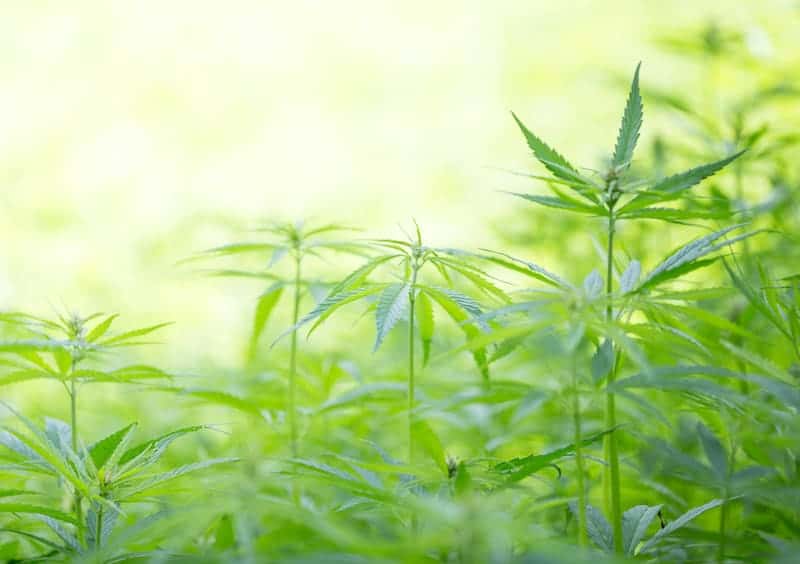Do I Have Marijuana in My Yard?
I recently moved to a new house with new plants and shrubs around our yard. Some of the new plants I’m not familiar with and I began to wonder if cannabis might be growing in my yard. After some quick research, I realized this was not the case. I did realize that there might be others out there who have noticed a strange plant growing in your backyard. Maybe you’re not sure what it is? Luckily for you, I’ve gathered some information that should answer these questions – keep reading to find out!
So, is marijuana growing in my lawn? More than likely, the answer is no. Cannabis can grow in the wild as the hemp plant – which has a psychoactive variety that produces marijuana. Even though many states have legalized certain uses of marijuana, growing it unlicensed is still a federal crime. If you have noticed a hemp plant – a.k.a. cannabis or marijuana, growing in your yard or in a neighbor’s yard, you should call the police.
The truth is, if you see a plant that you think is marijuana – it probably isn’t.
How to Identify a Marijuana Plant
There are a few things you can do to determine whether or not a plant is a pot plant, and we’ll talk about them right now.
Count the Leaves
 One of the easiest and most common ways to see if a plant is marijuana is to count the leaves. Counting a total of seven points with the middle being the longest, and all of them consisting of smooth-edged leaves should point to the plant being marijuana.
One of the easiest and most common ways to see if a plant is marijuana is to count the leaves. Counting a total of seven points with the middle being the longest, and all of them consisting of smooth-edged leaves should point to the plant being marijuana.
Marijuana leaves are often easy to spot because they are unusual-looking. You can always look up a picture online to check your findings! Many times, suspected marijuana plants turn out to be some type of weed that is taking over your lawn.
Smell
This one is fairly obvious – if you know what you’re looking for. Cannabis is known for its pungent smell and is very noticeable when the plant is in its prime. The smell is often associated with skunk or cat pee, both of which are not very pleasant. The good news is, that if you don’t notice a strong smell coming from the plant you’ve found, then it probably isn’t marijuana.
Look for Buds or Flowers
Buds are a later development in the growth of marijuana plants, so they aren’t always as noticeable as the other points of interest. Pot plants produce buds or pistils that are naturally produced hairs either white, orange, or red in color. They will be found in large quantities throughout the cannabis bud flowers.
Plants that Could Be Mistaken for Marijuana
Mother Nature is full of lookalikes. This can make it more challenging to identify a potential marijuana plant in your yard.
Here are 5 plants that are easily mistaken for marijuana plants – you should make sure to rule them out before taking any action:
- Japanese Maple: comes in several different varieties of leaf shape and color, but while in its growing stage with green leaves – it looks just like cannabis
- Chaste Tree: while growing, the leaves of the Chaste Tree are long and serrated like cannabis, with 5 to 6 leaves – but if fully grown, it’s quite obviously not a marijuana plant
- Cassava: the leaves of the cassava look like marijuana with a similar greenish colored leaf; they are directly attached to the stem and grown in a bunch
- Cranberry: before it blooms, the leaves of the cranberry hibiscus are large and colorful like cannabis leaves; after blooming, the leaves are much broader – similar to Maple leaves
- Hibiscus: the leaves of the hibiscus plant are slender and multi-branched; they don’t have very pointy edges but the long and thin textured leaves create the illusion of a cannabis plant
How to Get Rid of Marijuana Plants
Because the cannabis industry is so new and still highly regulated, there are many requirements that businesses must comply with when handling marijuana waste. In the same way, you’ll want to make sure that when you remove a pot plant from your yard, you’re doing it correctly. Failing to handle this tricky situation legally may contribute to a less than ideal situation in which you will need to hire a lawyer.
The smartest thing you can do is contact the authorities. You want to make sure that whatever you do is inside the law, even if the growth wasn’t yours in the first place. After the authorities have been contacted, they will likely either take care of removing it for you or inform you of the process.
There are not many specific guidelines on removing marijuana plants from personal yards or residences because it is still not a widely accepted or legalized form of growing. You should not just cut the plants and burn them though – you could have the police knocking down your door thinking you have a crazy party going on!
What You Need to Know About Marijuana
There are still many unknowns about marijuana: the benefits and the dangers of using it. It is becoming more widely accepted that there are medical conditions that improve or are eased by using/taking marijuana in some form. Under this type of use – you should always consult your healthcare provider before making any decisions.
Though times are changing, there is still a large majority of people that do not agree with or accept the use of marijuana – for medical reasons or for recreation. If you choose to partake in the consumption of marijuana, know this and be prepared for a variety of reactions.
Four common forms of cannabis and their uses, for your knowledge:
- Sativa: helps stimulate the mind and senses, improves concentration, increases energy, and uplifts mood
- Indica: relaxing for mind and body, relieves pain and nausea, stimulates appetite, and reduces anxiety
- Hybrid: helps to boost your mood and keep you relaxed; a balance between relaxation and euphoria
- CBD: relief for sore muscles, helps in reducing inflammation, alleviates chronic pain; good for post-exercise recovery
Each of these forms comes in many different varieties of products and methods for consumption or use.
Related Questions
Can I Get in Trouble for Having Marijuana in My Yard Without Knowing?
Depending on where you live, there are a few states that allow a certain quantity of marijuana grown for personal use. If this is the case, you will likely not get in trouble for having marijuana in your yard.
Most often, the police won’t be notified of anything suspicious unless it’s reported to them. If you aren’t smoking it where it’s illegal, you should not be in any trouble. If for some reason you are reported for having pot growing in your yard and it is not allowed where you live, you should be careful about how you handle the situation.
A warrant is something you should require that the cops present to you if they come knocking on your door and asking about illegal marijuana. Without a warrant, the authorities can only knock and ask – you have the right to refuse to show them anything. Phone calls from neighbors will not get the police a warrant, so you really shouldn’t have to worry.
Where is it Legal to Grow Marijuana for Personal Use?
Year after year, the regulations on the cannabis industry are modified, changed, made harsher or more lenient. As of 2020, there are 19 states that currently approve home growing of recreational cannabis or medical cannabis.
Some of those states include:
- Vermont
- Michigan
- Colorado
- California
- Maine
- Arizona
- Rhode Island
In regards to growing marijuana for personal use, there are still some rules focusing on the number and maturity of cannabis plants. The majority of the states require an age 0f 21 years before growing and limit the number of plants to less than 12 – with most not allowing all 12 to be mature.
If you’re thinking about growing your own marijuana – check your state’s regulations and make sure to get all of the licensing. You don’t want to get fined or a more serious punishment for not following all of the requirements and restrictions.
Thanks for reading American Lawns! You can find more lawn care tips from experts here.

